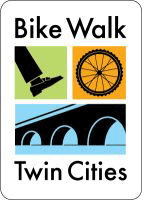 In September 2008, volunteer counters took to the streets with tally sheets, clipboards, and sharpened pencils to better understand how many people are walking and bicycling in Minneapolis and its neighboring communities.
In September 2008, volunteer counters took to the streets with tally sheets, clipboards, and sharpened pencils to better understand how many people are walking and bicycling in Minneapolis and its neighboring communities.These counts are part of a continued data collection process to learn more about bicycle and pedestrian behavior in the Minneapolis area. Undertaken collaboratively by Transit for Livable Communities (TLC) and the Department of Public Works at the City of Minneapolis as part of the Bike Walk Twin Cities (BWTC) initiative, the counts also provide a baseline for measuring the impacts of bicycle and pedestrian investments made throughout the BWTC initiative.
In this report, we can see that bicycling and walking increased during 2008. At locations where counts were performed in both 2007 and 2008, walking increased by six percent and bicycling increased by 29 percent. These numbers support the trends illustrated in the American Commuter Survey (ACS) from 2005 to 2007, which also shows increases in walking and bicycling.
By itself, this information is little more than an interesting statistic. Over time, counts and other data collection—combined with strong collaboration with local governments, businesses, organizations, and residents—can help local leaders make better informed decisions about bicycling and walking investments. Through Bike Walk Twin Cities, Transit for Livable Communities will continue to collect data to measure increases and decreases in walking, bicycling, and driving. To enhance the reliability of the data, TLC is beginning a monthly count at selected locations, and is also considering adding automated counters.
The mission of the Bike Walk Twin Cities initiative is simple: increase walking and bicycling, and reduce driving in Minneapolis and its neighboring communities. It is also about ensuring that more people have a voice in the transportation decisions that impact their lives, which is why we work closely with local governments, businesses, organizations and residents, in our decisionmaking processes. Ultimately, the Bike Walk Twin Cities initiative will provide new insights into travel choices and how people interact with the built environment, and we thank all of the people who have helped make this work possible.
We welcome your thoughts and questions. Your input helps us make the Twin Cities an even better place to walk and bike.
To find a copy of the report and maps showing count locations, click here.


